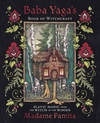How to Create an Altar to Honor Baba Yaga

In my book, Baba Yaga's Book of Witchcraft, I take you on a journey to meet the Slavic witch of the woods and teach the old spiritual traditions that can bring you closer to her. Despite Baba Yaga's reputation as a tough taskmaster, I've encountered many people who feel called to connect with this ancient wise woman—to learn from her, to meld with her magic, or simply to honor this powerful crone spirit. If you're one of them, I welcome you to come closer to her little khata, her initiation hut standing on chicken legs.
Be prepared. Baba Yaga is not an easy teacher. And she is definitely no pushover. She will challenge you, she will test you, and she will push you farther than you ever believed you could go. But, like a tough coach or a domineering drill sergeant, perhaps it's because she believes in you more than you may believe in yourself. To work with her takes courage, intelligence, resourcefulness, and even a little bit of moxie, but if you're ready for the challenge, you'll reap incredible rewards—climbing higher, going farther, and doing more than you ever thought possible.
There are so many ways to dive into her magic, and I go through dozens of them in my book, but if you're just getting introduced to her, you may want to start by building an altar to her in your home. Assembling an altar is a great way to become familiar with a deity or spirit. It's the spiritualist's version of inviting a guest into your home. If you create an altar, it allows you to get to know the spirit and for the spirit to get to know you. An altar done with care and respect is like giving your divine guest the best seat in the house—it shows them that you honor them and would like to deepen your relationship with them.
Baba Yaga Altar Basics
To set up an altar doesn't require elaborate or expensive equipment. You may have most of what you need and the rest can be sourced easily and inexpensively. Baba Yaga is a spirit of nature, so you'll discover that much of what you need can be gathered outside for free and the other offerings are at their most powerful when crafted by you.
Start by finding a place for your altar—a small end table, a shelf, or even a windowsill can serve as an altar space. If you have a fireplace mantle, that is a special place to honor her. In ancient Slavic countries, the hearth was seen as a place to connect to ancestors and spirits, and she has legendary connections to the old Slavic wood stoves. If you want to be very traditional, you could set up a shelf on the wall in the eastern corner of your home to serve as an altar. This corner shelf altar, called a pokut', has long been a place to honor spirits, deities, saints, and ancestors since pre-Christian times. It was traditionally set above the dining table to invite the spirits to our meals and show them hospitality.
Wherever and however you set up your altar, make sure that it is a space solely dedicated to your spiritual work. In other words, don’'t use your bedside nightstand with your phone, coffee, and books on it as an altar as well.
Setting Up Your Baba Yaga Altar
In setting up your altar, leaving the surface as-is can be fine. Just freshen it up by dusting it and removing anything not related to your altar set-up. If you want to show more respect, however, you can put a cloth on the altar. Place a tablecloth, scarf, or shawl in colors such as red, black, or green over the altar. Red represents fire and life force, black signifies the rich black earth that she is so deeply connected to, and green stands for her home in the woods. If you really want to pull out all the stops, you can create special cloths with talismanic embroidery called rushnyky, as I teach you how to do in my book, and place one on the altar and drape another on the wall above like a small tent.
Once you have placed the cloth on the altar, you are ready to add an image or symbol of Baba Yaga. You can find an image online, print it out, and frame it. Alternatively, you can purchase a figurine or, if you're crafty, make one. There are lots of images of Baba Yaga out there and some of them can be downright terrifying. Do you really want to buy into that bad propaganda? My recommendation is to find a crone image that appeals to you, not one that is going to give you nightmares.
Adding Offerings to Your Baba Yaga Altar
Adding the offerings to an altar is one of my favorite parts of altar creation. It allows for you to design and express your creativity and create a beautiful space to connect to beloved spirits. Below is a list of possible items that you can add to your Baba Yaga altar. You don't have to add them all; just choose the ones that work for you and your space.
- Beeswax candle: Spirits love candles, and Baba Yaga, like many ancient Slavic spirits, has a connection to the fire of her pich, or wood stove. Lighting a candle for her will light her way and bring her closer. Beeswax is a material considered sacred to Slavic people, and so lighting a beeswax candle is a traditional way to bring the magic of her hearth fire to your altar.
- Bones: In many of her tales, Baba Yaga's hut is surrounded by a fence made of bones. As a special guardian of the gateway to the afterlife, Baba Yaga feels quite at home among bones. Chicken bones have a special connection to her, as her magical hut stands on two giant chicken legs, but bones of any animal will do. Some bones from your meal or bones of animals that you find on a nature walk, for example, are perfect. Clean them, dry them, and arrange them on the altar to make her feel warmly welcomed. As an alternative, you may put a figurine of a skeleton or skull to stand in for the real bones, if you prefer.
- Bread and Salt: In many Slavic countries, especially my ancestral homeland of Ukraine, braided loaves of bread with tiny dishes of salt pressed into the top are offered to honored guests to welcome them. Bread is the foundation of every meal and the salt, once a rare and expensive commodity, is a way of symbolically giving your guest the very best. The guest graciously tears off the piece of the bread and dips it in the salt before eating it to show their gratitude for the hospitality. Bake a homemade loaf or purchase a special bread for her. Tear off a piece of this bread and place it on your altar next to a small dish of salt. Baba Yaga is notorious for having a voracious appetite, and she will appreciate this familiar offering of nourishment and generosity. When the bread gets stale, remove it from the altar and offer it to the birds outside.
- Earth and Stones: Baba Yaga is the ruler of the Lower World, and so she is closely associated with snakes, serpents, and cave-dwelling dragons. Placing a dish of rich loamy soil or some common pebbles on your altar will honor her connection to the earth and her underground domain, and at the same time remind you that you can't judge by appearances. Humble-looking rocks have just as much spiritual power as the most sparkly crystal.
- Greenery: You can adorn your altar with some freshly-cut, potted, or dried greenery to bring Baba Yaga closer to you. While many spirits seem to favor flowers, Baba Yaga has different tastes. Apart from the wild poppies with which she is associated, she prefers plants that are highly magical. Branches respectfully gathered from birch, aspen, juniper, oak, spruce, and cedar will remind her of her forest home. Plants such as hemp, garlic scapes, fern fronds, mint, nettle, thistle, wormwood, or mugwort offer the magical properties that attract her and protect her sacred space.
- Mortar and Pestle: If you've ever heard one of the tales featuring Baba Yaga, you know that one of her most famous attributes is her mode of transportation—a giant mortar and pestle that she uses to fly through the sky or bump along on the ground through the forest. Putting a normal-sized mortar and pestle on her altar is a great way to connect to her and honor her witchy powers.
- Spindle and Fiber: Like many of the old female Slavic spirits, Baba Yaga is a master spinner and weaver, not just creating magical fabrics but fabricating the web of life itself. Placing an old drop spindle or some hand-spun yarn on her altar, or textile art that you have fabricated with your own hands, will tell her that you honor her skills. Whatever you do though, don't place unspun fibers on the altar. It will look like you're asking her to do your work for you.
- Water: Water is sacred in Slavic magic, and Baba Yaga is the keeper of the magical waters of Life and Death. Place a small glass, jar, or pitcher of water on the altar as an offering to her and an acknowledgment of her sacred magical role. If you can get fresh water from a natural spring or rainwater that you have collected, it will be the very best offering to her.
How to Work with Your Altar to Baba Yaga
Once you've created your altar to Baba Yaga, you want to work with it. Light your candle when you're at home and awake, and keep greenery, food, and water fresh. Sit near your altar and meditate or visualize meeting Baba Yaga. She might be a little quiet the first few times you encounter her; she has a way of sizing a person up before deciding whether she wants to work with them. However, if you come to her courageously yet respectfully, she may open up to you and offer you words of wisdom, advice, and magical gifts. And, if you keep the relationship going, you may even begin to feel care and love peeking out from under her gruff exterior. Never forget that she is the grandmother of all grandmothers—when you develop your relationship with her, she will light your path no matter how dark and dangerous the forest of life may get.
Madame Pamita is a Ukrainian diaspora witch, teacher, author, candle maker, spellcaster, and tarot reader. She has a popular YouTube Channel for teaching witchcraft; she hosts two podcasts, "Baba Yaga's Magic" and "Magic and the Law of Attraction," and she is the author of Baba Yaga's Book of Witchcraft, The Book of Candle Magic, and Madame Pamita's Magical Tarot. She is also the proprietress of the online spiritual apothecary The Parlour of Wonders and lives in Santa Monica, California. You can find her at parlourofwonders.com.

About Madame Pamita
Related Products


is subject to certain Terms and Conditions